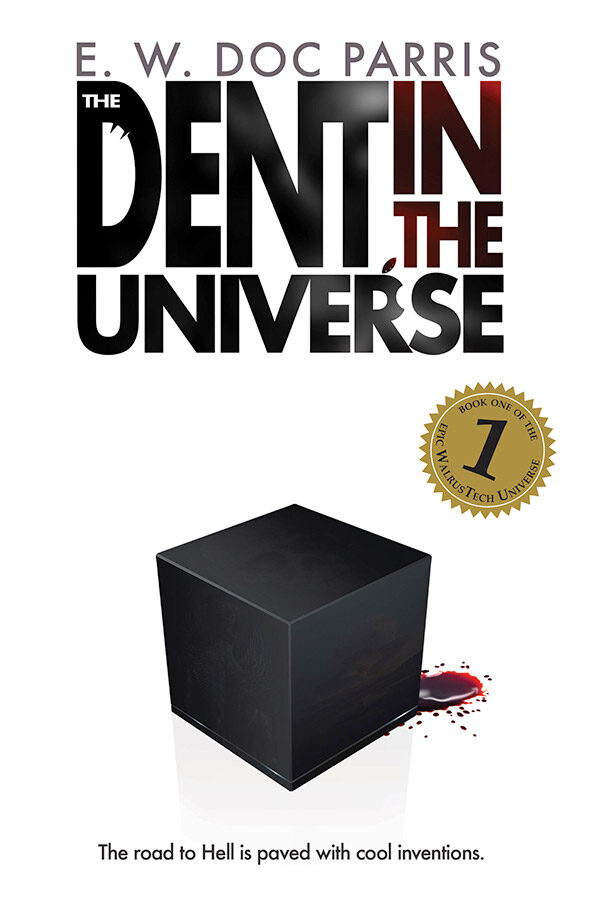E.W. Doc Parris has a new sci-fi/horror book out: The Dent in the Universe. And there’s a giveaway – a $50 Amazon gift card.
To resuscitate his fading celebrity, tech CEO Stephen Lucas would sell his soul for one more hit. When the subspace network for his holographic gaming empire crashes, his hardware guru makes a discovery proving that, though the mechanics may differ a bit, Einstein was right once again— information can be sent backward in time.
Lucas sees a dream product for procrastinators. Want a pizza now? Send your order back in time 30 minutes. Forgot to make reservations at that chichi french restaurant two weeks ago? No worries. Buy that PowerBall ticket. Invest in that stock. Make a FaceTime call to a loved one that passed away a month ago.
In a culture built on instant gratification, Lucas knows he has a hit that will make Wall Street sit up and beg. But when he rushes into beta testing, he learns that the stuff dreams are made of can quickly become the stuff of nightmares.
Warnings: violence, torture, body horror, branding, implied cannibalism.
Get It On Amazon | Universal Buy Link | Liminal Fiction | Goodreads
Giveaway
Doc is giving away a $50 Amazon gift card:
a Rafflecopter giveawayDirect Link: http://www.rafflecopter.com/rafl/display/b60e8d47282/?
Excerpt
Stephen picked up the keyboard and typed, Watson, come here. I want to see you.
Before he hit enter, the display on his right blinked and displayed a log entry. The display directly in front of him showed the log of the interaction, a white line of text that showed what he’d typed, Watson, come here. I want to see you, and the time sent, 630231 milliseconds. The display on the right, the one that flashed before he hit enter, showed the same.
Walrus said, “Look at the timestamps. The sending input occurred at 630231 milliseconds. The receiving event happened at 629931 milliseconds.”
Stephen looked puzzled. “The clocks are off? That’s a 300…?” he checked his math, “300-millisecond difference.”
Walrus grinned. “Negative 300 milliseconds. The clocks aren’t off.”
“The time server is off?” Stephen knew that was the culprit in the outage.
Walrus shook his head. “Nope. These two chips are in perfect sync to FTL time.”
Stephen stopped and thought. The message appeared to be arriving 300 milliseconds before it was sent. “I’m not getting it,” he said.
Walrus laughed and did his little dance again. “Yes! You are! Tell me what you see.”
Stephen said slowly, “The message looks like it’s being received before it was sent, 300 milliseconds before.” Walrus grinned, and Stephen continued, “But that’s not possible. What’s causing the discrepancy? If the clocks aren’t wrong and the time server was working properly…?” He shook his head.
Walrus’s grin widened. “It’s a time machine.”
Stephen leaned back a bit from the desk. “Right.” Walrus let it sink in. “What do you mean?” He thought Walrus was speaking metaphorically.
Walrus laughed and said, “I mean, this is a time machine.”
Stephen looked at the set-up in front of him. It was a hacked sChip on a breadboard and a couple of displays strung together with cables and alligator clips. This wasn’t a time machine.
Walrus relented. “I’ve tweaked the power supply to dial in a tiny phase variance in the I/O to this sChip, like our customer did by accident. The tensor array interpreted this as an attribute, sending the signal to a point in time before it was sent. 300 milliseconds before. About a third of a second.”
Stephen recalled the chain of events. The right display refreshed a fraction of a second before he hit enter. Examining the log, what he had typed was there. Watson, come here. I want to see you.
He frowned and thought for a few seconds. “A third of a second? It’s the least impressive time machine imaginable,” he said. “This crashed the time servers?”
Walrus nodded, finished his cola, tossed its crushed container in the recycling bin, and peeled open another. “Essentially. I’ve cleaned up the effect, and I’m not messaging the time server. The timeserver would have ignored an invalid time sync transaction. It’s programmed to dump garbage bits. This wasn’t garbage, it was a perfectly normal sync transaction, but the handshake was out of order. The time server software questioned its own reality. It wobbled, tried to regain its equilibrium, and tipped into cascade failure.”
“It’s fascinating, but…” Hard-wired by the last six years to search for a new product, Stephen’s mind was searching for a use for what he was seeing. “I mean, it is cool, but it’s useless—a weird trick of physics. What can we do with it?” He thought for a little more. “This is IP data?”
Walrus shrugged, “It’s a packet like any other packet.”
“So, if it’s packets, then it’s IP, then it’s anything. Form data, text, jpegs, audio, video, holo.”
Walrus nodded and grinned, “Sure. You could surf the web of 300 milliseconds ago…”
Stephen interrupted him, “Can we extend that? Could we rig these in series? Go back further?”
“We could do it more elegantly than that—How much further?”
“You tell me, what’s the theoretical limit?”
“Well, you’d need a receiver. So whatever we end up making would only go back to the first chips that go online. We make a chip today, turn it on, in a week, we could go back to that moment but not before, right? The longer we’re online, the further back we can send things.”
Stephen shook his head. “We couldn’t go back further than tonight?”
Walrus nodded. “There would be nothing to send it to. As soon as we flip the switch on our time machine, we’d be establishing a time horizon. But say we turned on a receiving device tonight. In a year, you could send a message back to tonight. That would be a year in your past. In two years, you could send a message back two years, on and on, until the end of the world.” He laughed and said, “You know that old site, The Way Back Machine? The internet archive? This would be like that but live. You could actually surf the web of the past. Leaving comments on a video from a year earlier.”
Stephen frowned dismissively and said, “What good would that do? I can leave a comment on that same video today. The entire internet is available back to the 90s.”
Walrus smiled, “But it’d be radical!” Radical was not the goal. Stephen needed a killer application, a product everyone would want. Walrus’s stomach growled loudly. “Man,” he said, “I’m starving. Wanna order a pizza? Hey man, that’s what we could do!” he said jokingly, “We could use it to order pizza a half hour ago, so it arrives…” and he snapped his fingers.
Stephen froze. His pupils widened. Instant Pizza. Instant delivery. Instant gratification.
The entire computer industry of the last forty years was built around delivering everything as quickly as possible. Meeting the desires of the customer. Right. Fucking. Now. If no one ever went broke underestimating the American people’s intelligence, as Mencken might have said, it would follow: no one ever went broke catering to their impatience.
Author Bio
E.W. Doc Parris is an American writer known for matter-of-fact, hard science fiction grounded in the current scientific weltanschauung, leavened with wit, and kindled by the warmth of human relationships.
Born within the nation’s capital Beltway, Doc makes his home in the foothills of Virginia’s Blue Ridge. A self-taught software developer and solutions architect, he’s made a decent living over the years as a set designer, graphic designer, animator, 3D modeler, iOS developer, puppeteer, and educator.
In addition to his centuries-spanning WalrusTech Reality series, Doc is currently working on his next novel, Land of Nod, an exploration of A.I., nanotech, and the human brain’s neural network.
Author Website: https://www.ewdocparris.com
Author Mastadon: @ewdocparris@writing.exchange
Author Instagram: https://www.instagram.com/ewdocparris/
Author Goodreads: https://www.goodreads.com/ewdocparris




